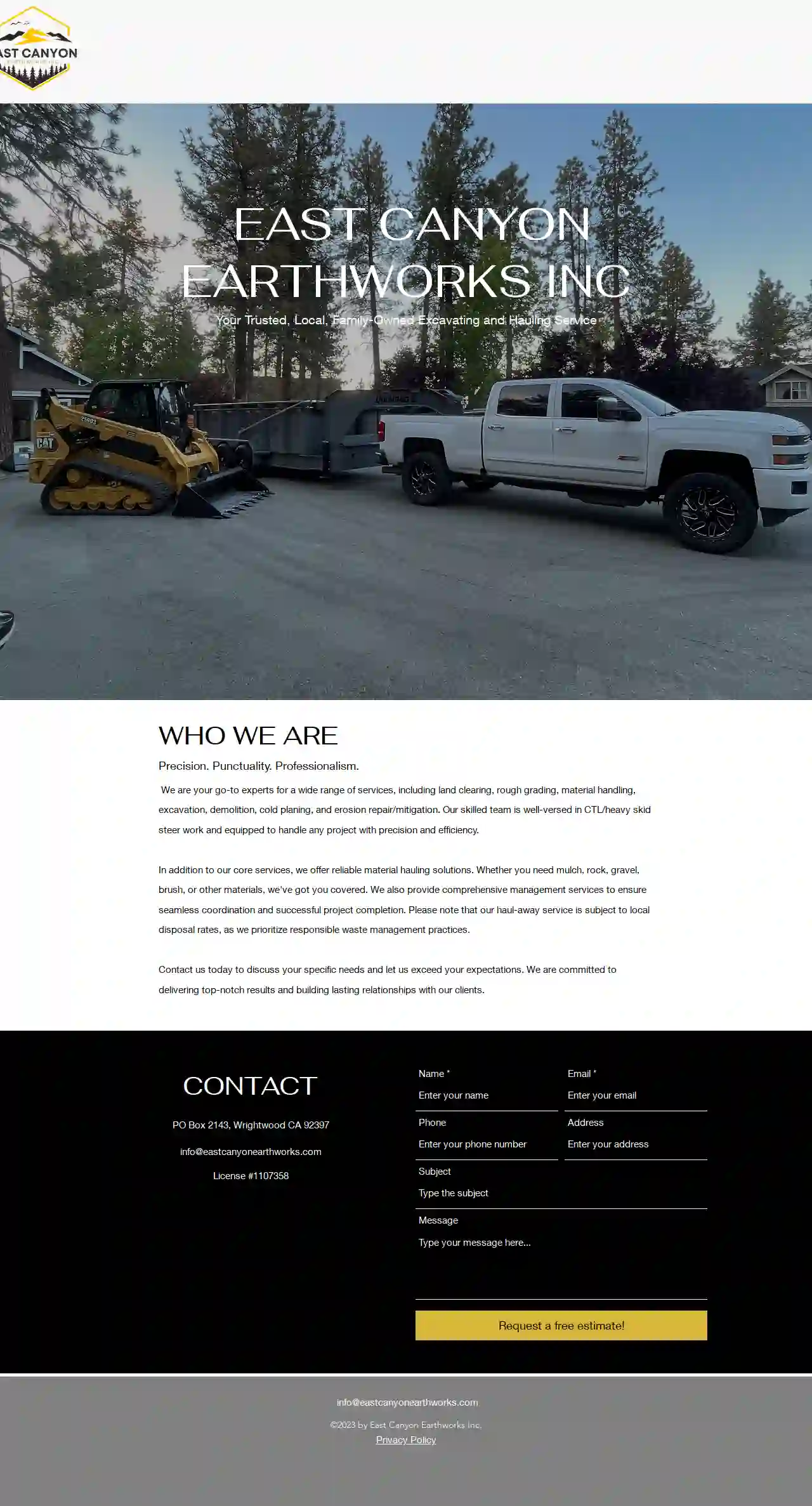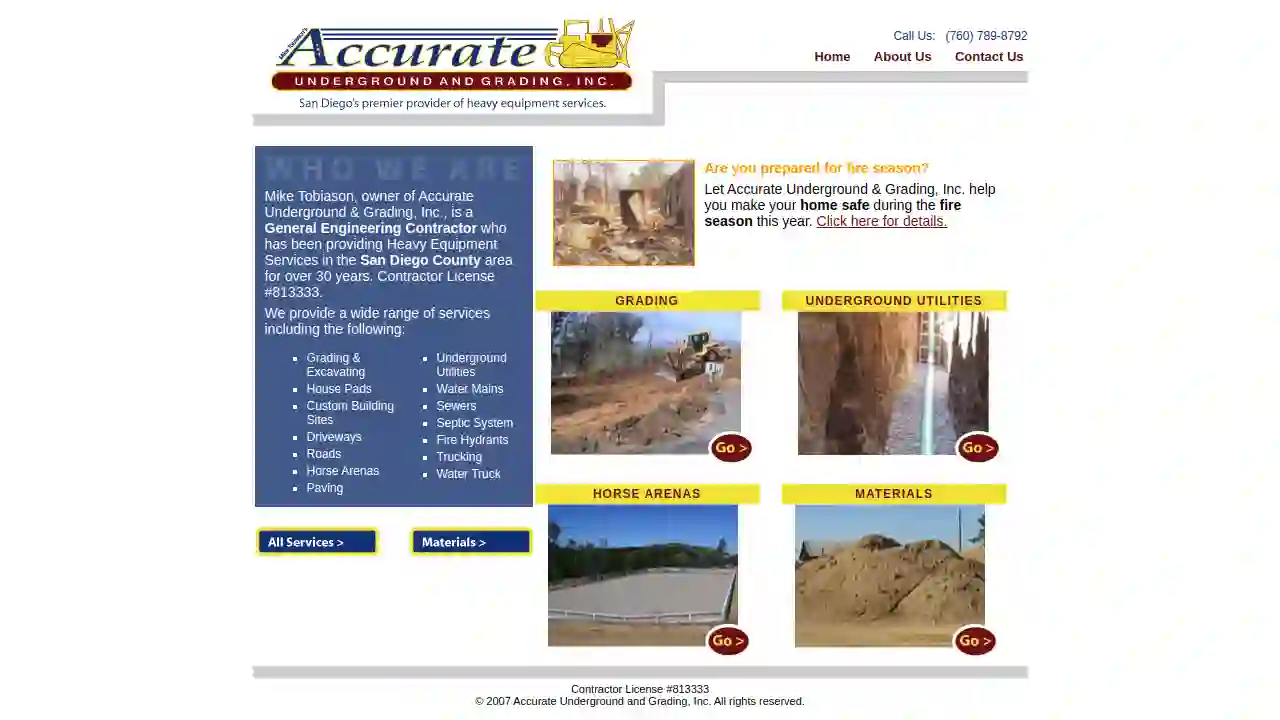Excavation Contractors Contra Costa Centre
Find Excavation Company Near Me in Contra Costa Centre
Get multiple Excavation Contractor quotes for your project today! Compare profiles, reviews, accreditations, portfolio, etc... and choose the best service.

Schreiber Excavating
53 reviews1767 Kenyon Road, Ontario, 14519, USSchreiber Excavating has a long history of happy clients across New York State. You can expect only the best in construction, utility installation, and trucking services from Dan and his team. Working at an expert level in construction requires highly trained workers and precision equipment. We use only the most advanced technologies to ensure safety, efficiency, and the best price possible. At Schreiber Excavating, our top priority is client satisfaction. You can expect a job well done—every time. Schreiber Excavating has a proven track record of delivering only the finest quality site work and utility services from initial conception to final product. Our highly trained team places safety first while maintaining a diligent focus throughout the entire process. You can trust Schreiber Excavating to make your construction a reality.
- Services
- Why Us?
- Testimonials
- Gallery
Get Quote
Coastal Excavation & Construction Inc
51 reviewsPO 585, Goleta, 93116, USMeet Chad Cushman - Founder of Coastal Ex Founded in 2007 by Santa Barbara native and avid waterman, Chad Cushman - Coastal Ex started with a vision as expansive and clear as the California coastline. Just as the coast is a dynamic meeting point of land and sea, Cushman saw an opportunity to bridge creativity and stability in the construction industry. Cushman’s strong compass, guided by a commitment to quality, reflects his unwavering dedication to excellence amidst ever-changing conditions. Each project under his direction embodies his commitment to meticulous craftsmanship and innovative thinking and problem solving in a dynamic industry. Coastal Excavation and Construction continues to stand as a testament to the integrity and enduring quality that define his vision and the essence of the coastal spirit. When he’s not on site with his team, you can find Chad in his workshop welding, tending to his growing orchard or swimming in the Pacific Ocean that he’s grateful to call his backyard. Decades of Results Coastal Excavation & Construction is a highly skilled and licensed general engineering contractor specializing in a wide range of services, from custom design and drawings to demolition, excavation, grading, trenching, pipe installation, backfill, drainage, erosion control, footings, foundations, structural building, light duty building, pool excavation, driveways, hardscapes, septic systems, fire prevention, land clearing, heavy duty landscaping, and hauling. With a commitment to quality and customer satisfaction, Coastal Ex has been serving the Santa Barbara County and Central Coast communities for over 15 years. Their team of experienced professionals is dedicated to providing exceptional service and delivering projects on time and within budget. Whether you're looking to build your dream home, renovate your existing property, or tackle a challenging landscaping project, Coastal Ex has the expertise and resources to make your vision a reality.
- Services
- Why Us?
- Our Team
- Gallery
Get Quote
Beaver Land Clearing LLC
52 reviews3980 Lake Mary Boulevard, 3980 E Lake Mary Blvd., Sanford, 32773, USOur Story At Beaver Land Clearing, we provide a comprehensive range of services, including Tree Services in Sanford, Land and Lot Clearing, Commercial Landscaping in Lake Mary, and Tree Services in Lake Mary. We also offer professional Excavator Contractor, Bobcat, and Aerial Boom Lift Services. Our commitment to excellence drives us to consistently exceed our customers' expectations. Our Services We offer a wide array of services, encompassing Tree Services in Sanford, Land and Lot Clearing, Commercial Landscaping in Lake Mary, Tree Services in Lake Mary, and Lawn Maintenance. Our skilled team possesses the necessary tools and expertise to handle any project, regardless of size. Contact us today at (386-216-2208) to discuss your needs. Our Process At Beaver Land Clearing, we believe in a personalized approach to deliver exceptional results. We collaborate with you to develop a tailored plan, whether it's a manual or 3D Landscape Design, that aligns with your specific requirements and budget. Our team then executes the plan with precision and care, ensuring your trees, land, and landscaping are healthy and aesthetically pleasing. Commercial And Residential Beaver Land Clearing provides expert Tree Services in Sanford, Commercial Landscaping in Lake Mary, and Land and Lot Clearing services. We also offer emergency services for Storm Disasters and Storm prep. We're here to assist you with all your tree care and landscaping needs.
- Services
- Why Us?
- Gallery
Get Quote
H.I.G Contractors
54 reviews123 Main Street, Anytown, 12345, USAbout HIG Contractors HIG Contractors is a family-owned and operated business with over 20 years of experience in the construction industry. We are committed to providing our clients with high-quality workmanship and exceptional customer service. We specialize in a wide range of construction services, including: Residential construction Commercial construction Renovations Additions Roofing Siding Windows and doors Decks and patios And more! We are fully licensed and insured, and we are proud to be a member of the Better Business Bureau. We are committed to providing our clients with a positive and stress-free construction experience. We work closely with our clients to ensure that their project is completed on time and within budget. We are also committed to using environmentally friendly building practices whenever possible. If you are looking for a reliable and experienced construction company, look no further than HIG Contractors. We are dedicated to providing our clients with the highest quality construction services available.
- Services
- Why Us?
- Testimonials
Get Quote
Sierra Construction
51 reviewsPO Box 5080, Sonora, CA, PO Box 5080 Sonora, 95370, USAbout Us We are an A and B licensed contractor located in Tuolumne County, CA. Our expertise is in grading and excavation. We offer high quality service for affordable prices that put us a step ahead of the competition. PROMPT AND RELIABLE At Sierra Construction our clients are our priority. We take pride in doing what we say we will do in regards to project timelines/budgets and we go the extra mile to make sure our customers are completely satisfied with our work. Call us today and find out what we can do for you.
- Services
- Why Us?
- Gallery
Get Quote
East Canyon Earthworks Inc
54 reviewsPO Box 2143, Wrightwood, 92397, USEAST CANYON EARTHWORKS INC Your Trusted, Local, Family-Owned Excavating and Hauling Service WHO WE ARE Precision. Punctuality. Professionalism. We are your go-to experts for a wide range of services, including land clearing, rough grading, material handling, excavation, demolition, cold planing, and erosion repair/mitigation. Our skilled team is well-versed in CTL/heavy skid steer work and equipped to handle any project with precision and efficiency. In addition to our core services, we offer reliable material hauling solutions. Whether you need mulch, rock, gravel, brush, or other materials, we've got you covered. We also provide comprehensive management services to ensure seamless coordination and successful project completion. Please note that our haul-away service is subject to local disposal rates, as we prioritize responsible waste management practices. Contact us today to discuss your specific needs and let us exceed your expectations. We are committed to delivering top-notch results and building lasting relationships with our clients.
- Services
- Why Us?
- Gallery
Get Quote
JS Company Inc. - Js Co.
53 reviewsBrentwood, USABOUT JS COMPANY AN AFFORDABLE CONTRACTOR YOU CAN TRUST JS Co. is a locally owned, insured and licensed general engineering firm founded in 1998. Its mission is to become your preferred contractor in the San Francisco Bay Area, offering a gamut of services to complete any project. There is no “too small” or “too large” job for us. Count on JS Co. to provide speedy and fair estimates whether you are a homeowner, a business representative, an insurance adjuster or a public official. Our team of friendly and talented professionals is ready to exceed your expectations starting with your initial contact until the completion of your project. Review our strength in numbers and learn more about some of our happy clients in our References section. 0 + YEARS OF EXPERIENCE 0 + PROJECTS COMPLETED 0 + SATISFIED CLIENTS 0 + CONSTRUCTION LICENSES LET JS COMPANY BECOME YOUR PREFERRED CONTRACTOR JS has delivered hundreds of projects to hundreds of clients for over two decades. We look forward to assisting you with your next project. Give us the chance to earn your business! Call Us at 415-460-2100
- Services
- Why Us?
- Testimonials
- Gallery
Get Quote
A-ROD Construction
54 reviewsSuite 100, 6010 McPherson Rd., Laredo, 78041, USA-ROD Construction Inc. A-ROD Construction Inc. is proudly owned by South Texan and Native Laredoan, Armando “Mando” Rodriguez. At A-ROD Construction, we take great pride in our work and value our customers as our primary asset. The company was established in the year 2000 as a fully-bonded heavy equipment dirtwork and asphalt operator. We have been proudly serving Laredo and surrounding areas in South Texas with over 20 years of experience. We specialize in site work, excavating, and asphalt paving. Our other services include underground utilities, subdivisions, mass earth work, warehouse pad sites, concrete work, and much more. Contact us for all of your Commercial, Industrial, or Residential construction needs. As of 2019, we have been proud to announce our expansion to San Antonio, Texas and surrounding areas. Today, A-ROD Construction has continued to grow & expand rapidly, while earning a trusted reputation due to the satisfaction of our valued customers. Commercial, Residential, and Industrial Projects Our scope of work includes Commercial, Residential and Industrial projects. If you are interested in our wide range of services and the value that we can bring to your operation, let’s discuss your project today! Contact A-ROD Construction now.
- Services
- Why Us?
- Gallery
Get Quote
Accurate Underground & Grading
51 reviews1315 Walnut Street, Ramona, 92065, USAbout Us Accurate Underground & Grading, Inc. is a family-owned and operated business that has been serving the San Diego County area for over 30 years. Owner Mike Tobiason is a General Engineering Contractor with over 30 years of experience in the industry. Mike was born and raised in Ramona and started working with his father Angus at a young age. He learned the trade from the ground up, operating equipment and installing septic systems. In 1982, Mike started his own business, Accurate Underground & Grading, Inc. Since then, the company has grown into a thriving mid-sized excavating company, providing a wide range of services to residential and commercial clients. Our Commitment to the Community Accurate Underground & Grading, Inc. is committed to giving back to the community. We support many different community events, including the Ramona Boys & Girls Club, Grad-Nite, the Ramona Jr. Fair & Livestock Auction, Ramona Pony Baseball, Ramona Girls Softball, Poway Girls Softball, the Ramona 4th of July Fireworks, and the Ramona Lutheran School Playground. Our Team Mike and his team are dedicated to providing high-quality services to their clients. They are committed to safety, efficiency, and customer satisfaction. Accurate Underground & Grading, Inc. is a company that you can trust to get the job done right.
- Services
- Why Us?
- Our Team
- Gallery
Get Quote
Southern Excavation and Landscape LLC - Lawn Maintenance And Site work Contractor
530 reviews2028 Shepherd Rd #127, Mulberry, 33860, USSouthern Excavation & Landscape: Your Trusted Partner for Polk County's Landscaping and Excavation Needs Southern Excavation and Landscape is a well-established company located in Mulberry, Florida, USA. Founded in 2007 by Dakota Johnson, we have over 15 years of experience in the industry. Dakota's vision was to provide reliable and affordable lawn and landscaping services to the local community, and we've since expanded to include excavation services. In 2022, Waylon Cochran joined forces with Dakota to further elevate Southern. Waylon's expertise in business management has been instrumental in streamlining our operations and ensuring we deliver the highest quality work efficiently. We're committed to exceeding customer expectations and providing exceptional service. Southern Excavation and Landscape is a full-service company offering a comprehensive range of services, including: Lawn Maintenance Landscaping Excavation & Dirt Work And much more! We utilize the latest equipment and techniques to ensure projects are completed to the highest standards. Safety is paramount to us, and we prioritize the well-being of our employees and customers throughout every project. Our team of highly skilled and experienced professionals is dedicated to providing exceptional service to our clients. We work closely with you to understand your specific needs and preferences, ensuring your satisfaction is always our top priority.
- Services
- Why Us?
- Our Team
- Gallery
Get Quote
Over 22,076+ Excavation Companies registered
Our excavation pros operate in Contra Costa Centre and beyond!
ExcavationHQ has curated and vetted Top Excavation Contractors arround Contra Costa Centre. Find a top & trustworthy contractor today.
Frequently Asked Questions About Excavation Contractors
- Sloped Property: Your property has a significant slope, making it prone to soil erosion or landslides.
- Creating Usable Space: You want to level off a sloped area to create a flat surface for patios, gardens, or other outdoor spaces.
- Preventing Damage: Erosion is threatening existing structures, driveways, or walkways.
- Landscaping Features: You're incorporating tiered gardens, raised beds, or other landscaping elements requiring soil retention.
- Soil Type and Stability: Stable, cohesive soils allow for deeper excavations than loose or unstable soils.
- Groundwater Level: Excavations below the water table require dewatering techniques to manage water intrusion.
- Equipment and Resources: The size and capabilities of excavation equipment influence the achievable depth.
- Safety Regulations: OSHA and other safety regulations impose limitations on trench depths without proper shoring or sloping.
- Project Requirements: The purpose of the excavation (basement, pool, foundation) determines the necessary depth.
- Trench Collapses: Unstable trench walls can cave in, posing a severe risk to workers. Proper shoring and sloping are crucial safety measures.
- Utility Damage: Striking underground utilities (gas, water, electric) can cause leaks, explosions, or electrocution. Accurate utility locates and careful digging are essential.
- Falling Objects: Materials or equipment falling into excavations can injure workers. Securing work areas and using appropriate safety gear is vital.
- Equipment Accidents: Operating heavy machinery involves risks of rollovers, collisions, or mechanical failures. Trained operators and proper equipment maintenance are critical.
- Environmental Hazards: Excavated soil might contain hazardous materials (asbestos, lead). Proper testing and disposal procedures are necessary.
- Planning and Surveying: Defining the excavation area, marking utility lines, and determining the required depth and grade.
- Site Preparation: Clearing vegetation, removing obstacles, and ensuring site accessibility.
- Excavation: Using appropriate equipment (excavators, backhoes, etc.) to remove earth and create the desired excavation.
- Hauling and Disposal: Transporting excavated material to designated disposal sites, complying with environmental regulations.
- Backfilling and Compaction: Refilling the excavation with suitable material and compacting it to achieve the required density and stability.
- Grading and Finishing: Leveling and shaping the surface to the final grade for landscaping or construction.
How do I know if I need a retaining wall?
How deep can you excavate?
What are the risks associated with excavation?
What is the excavation process?
How do I know if I need a retaining wall?
- Sloped Property: Your property has a significant slope, making it prone to soil erosion or landslides.
- Creating Usable Space: You want to level off a sloped area to create a flat surface for patios, gardens, or other outdoor spaces.
- Preventing Damage: Erosion is threatening existing structures, driveways, or walkways.
- Landscaping Features: You're incorporating tiered gardens, raised beds, or other landscaping elements requiring soil retention.
How deep can you excavate?
- Soil Type and Stability: Stable, cohesive soils allow for deeper excavations than loose or unstable soils.
- Groundwater Level: Excavations below the water table require dewatering techniques to manage water intrusion.
- Equipment and Resources: The size and capabilities of excavation equipment influence the achievable depth.
- Safety Regulations: OSHA and other safety regulations impose limitations on trench depths without proper shoring or sloping.
- Project Requirements: The purpose of the excavation (basement, pool, foundation) determines the necessary depth.
What are the risks associated with excavation?
- Trench Collapses: Unstable trench walls can cave in, posing a severe risk to workers. Proper shoring and sloping are crucial safety measures.
- Utility Damage: Striking underground utilities (gas, water, electric) can cause leaks, explosions, or electrocution. Accurate utility locates and careful digging are essential.
- Falling Objects: Materials or equipment falling into excavations can injure workers. Securing work areas and using appropriate safety gear is vital.
- Equipment Accidents: Operating heavy machinery involves risks of rollovers, collisions, or mechanical failures. Trained operators and proper equipment maintenance are critical.
- Environmental Hazards: Excavated soil might contain hazardous materials (asbestos, lead). Proper testing and disposal procedures are necessary.
What is the excavation process?
- Planning and Surveying: Defining the excavation area, marking utility lines, and determining the required depth and grade.
- Site Preparation: Clearing vegetation, removing obstacles, and ensuring site accessibility.
- Excavation: Using appropriate equipment (excavators, backhoes, etc.) to remove earth and create the desired excavation.
- Hauling and Disposal: Transporting excavated material to designated disposal sites, complying with environmental regulations.
- Backfilling and Compaction: Refilling the excavation with suitable material and compacting it to achieve the required density and stability.
- Grading and Finishing: Leveling and shaping the surface to the final grade for landscaping or construction.